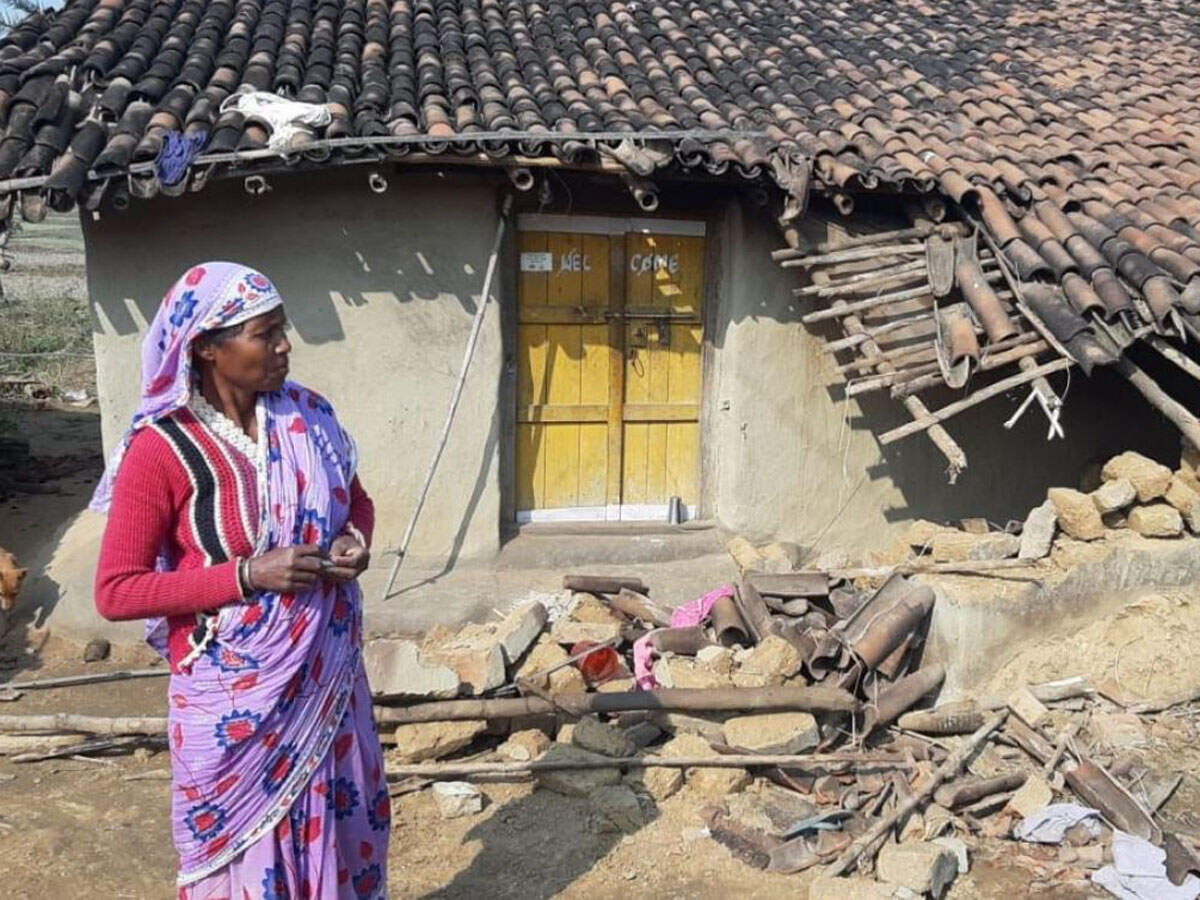Jharkhand: Wild elephants on rampage, villagers seek refuge in government middle school; Pathalgarhi movement acting as a deterrent

RANCHI: Eight families of a village in Khunti’s Arki block in Jharkhand have sought refuge in a government middle school in an adjacent hamlet after a herd of wild elephants, drawn by the scent of Hariya (rice-beer), went on a rampage and razed their kuccha houses late on Saturday night.
At least 10 houses in the tribal-dominated Sasangbera village were completely damaged after the 17-member strong elephant herd, which migrated from West Bengal, razed their walls, damaged utensils and killed a buffalo in a mayhem which began little after 10pm and lasted for an hour.

Petrified Bindu Devi, Mangala Devi, Sonia Devi, Budhram Lohra, Bahadur Lohra, Sitaram Munda, Bulu Munda, Domni Bala and Durgamani Devi spent the chilling night in open with their families even after the elephant herd retreated after leaving a trail of destruction. They were moved to Sirkadih Middle School premises in the neighboring Sindri village by the Khunti district administration on Sunday morning.

Arki’s block development officer (BDO) Gautam Kumar Sahu said the affected families have been given new blankets, a quintal of rice and potatoes as immediate relief. “Out of 10 houses, eight have been completely damaged. The affected families will be given pucca houses under government scheme. The magnitude of damage is being assessed. Thereafter, compensation will be disbursed by the department of forest, environment and climate change,” he added.
Khunti’s foresters are living on the edge. DFO Niranjan Prasad Dev said besides the rampaging herd, another herd of seven elephants (including a calf) was seen around 3am in a forest patch near to the adjacent Todang, Kothadih and Baredih villages. “On Saturday evening, the herd ransacked barns and damaged standing crops,” Dev said.

Arki comes under the Tamar forest range which overlaps the neighboring Ranchi district and is a prominent migratory route of wild elephants between Jharkhand and West Bengal. Increasing human interference has led to a rise in man-animal conflicts in recent years. In 2018, the forest department distributed compensations in 164 incidents of damages to life, property, crops and infrastructure caused by elephant attacks from the range. In 2019, more than 210 cases were reported in the area. “In 2019-20 FY, we have compensations amounted to Rs 1 crore in cumulative of which Rs 70 lakh has been disbursed,” Dev said.
Besides harvest, elephants are drawn to the scent of rice-beer which are brewed in these hamlets during the winter. “Two days ago, a lone male tusker entered Sasangbera and devoured Hariya which was kept in drums after brewing,” Tamar’s forest ranger Amarnath Bhagat said.
Pathalgarhi movement
Interestingly, Pathalgarhi movement is also acting as a deterrent in thwarting such conflicts. A forester said request anonymity: “After Pathalgarhi uprising in 2018, locals have turned hostile and not allowing us to enter their villages. The forest department is trying to create forest conservation committees in these villages which will in turn will arm the villagers with torches, searchlights and other equipment to keep elephants at bay. But the locals are not cooperating. So far, we have only been able to constitute 40 such committees in 120 odd villages in the range, which is spread over an area of 100 square kilometers.”
At least 10 houses in the tribal-dominated Sasangbera village were completely damaged after the 17-member strong elephant herd, which migrated from West Bengal, razed their walls, damaged utensils and killed a buffalo in a mayhem which began little after 10pm and lasted for an hour.

Petrified Bindu Devi, Mangala Devi, Sonia Devi, Budhram Lohra, Bahadur Lohra, Sitaram Munda, Bulu Munda, Domni Bala and Durgamani Devi spent the chilling night in open with their families even after the elephant herd retreated after leaving a trail of destruction. They were moved to Sirkadih Middle School premises in the neighboring Sindri village by the Khunti district administration on Sunday morning.

Arki’s block development officer (BDO) Gautam Kumar Sahu said the affected families have been given new blankets, a quintal of rice and potatoes as immediate relief. “Out of 10 houses, eight have been completely damaged. The affected families will be given pucca houses under government scheme. The magnitude of damage is being assessed. Thereafter, compensation will be disbursed by the department of forest, environment and climate change,” he added.
Khunti’s foresters are living on the edge. DFO Niranjan Prasad Dev said besides the rampaging herd, another herd of seven elephants (including a calf) was seen around 3am in a forest patch near to the adjacent Todang, Kothadih and Baredih villages. “On Saturday evening, the herd ransacked barns and damaged standing crops,” Dev said.

Arki comes under the Tamar forest range which overlaps the neighboring Ranchi district and is a prominent migratory route of wild elephants between Jharkhand and West Bengal. Increasing human interference has led to a rise in man-animal conflicts in recent years. In 2018, the forest department distributed compensations in 164 incidents of damages to life, property, crops and infrastructure caused by elephant attacks from the range. In 2019, more than 210 cases were reported in the area. “In 2019-20 FY, we have compensations amounted to Rs 1 crore in cumulative of which Rs 70 lakh has been disbursed,” Dev said.
Besides harvest, elephants are drawn to the scent of rice-beer which are brewed in these hamlets during the winter. “Two days ago, a lone male tusker entered Sasangbera and devoured Hariya which was kept in drums after brewing,” Tamar’s forest ranger Amarnath Bhagat said.
Pathalgarhi movement
Interestingly, Pathalgarhi movement is also acting as a deterrent in thwarting such conflicts. A forester said request anonymity: “After Pathalgarhi uprising in 2018, locals have turned hostile and not allowing us to enter their villages. The forest department is trying to create forest conservation committees in these villages which will in turn will arm the villagers with torches, searchlights and other equipment to keep elephants at bay. But the locals are not cooperating. So far, we have only been able to constitute 40 such committees in 120 odd villages in the range, which is spread over an area of 100 square kilometers.”
Trending Topics
LATEST VIDEOS
More from TOI
Navbharat Times
Featured Today in Travel
Get the app







